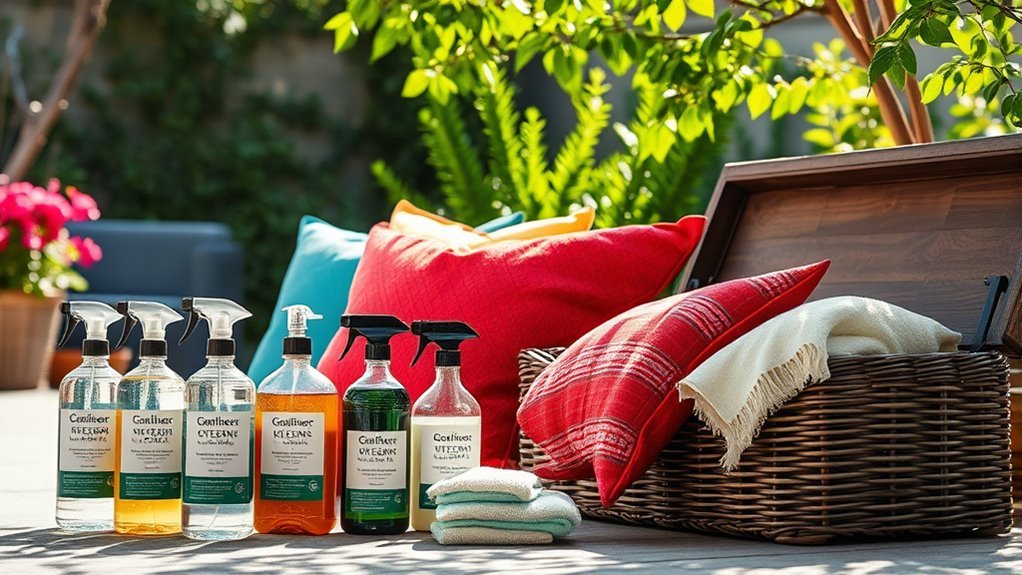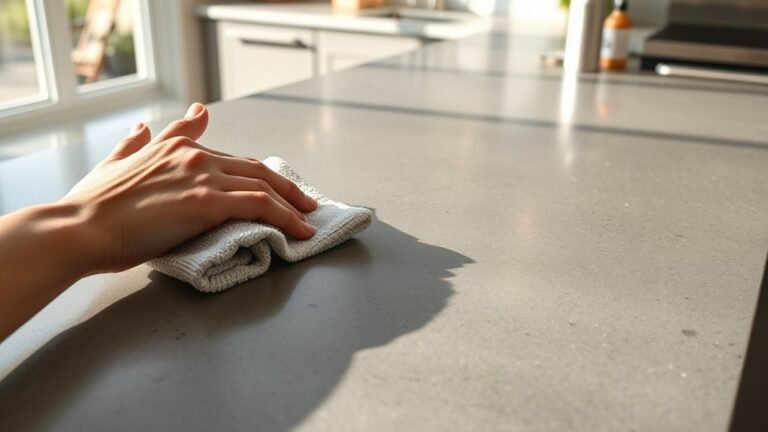Tips for Cleaning and Storing Outdoor Cushions
You’ll want to choose eco-friendly cleaners suited for your cushion fabric to keep them fresh and protected. Act quickly on stains using mild soap and cold water, and always dry cushions thoroughly to stop mold and mildew. Store them in breathable, waterproof containers in cool, dry places to extend their lifespan. Regular cleaning and proper storage prevent damage and fading, making your cushions last longer. Stick around to discover ways to maintain and prepare your cushions for every season.
Choosing the Right Cleaning Supplies

Before you start cleaning your outdoor cushions, it’s important to pick the right supplies. You want to choose eco friendly cleaners that protect both your cushions and the environment, giving you peace of mind while enjoying your freedom outdoors. Consider the fabric types of your cushions—whether they’re polyester, acrylic, or olefin—since different materials need different care. Using harsh chemicals on delicate fabrics can cause damage or fading, limiting your cushions’ lifespan. Look for gentle, biodegradable cleaners designed for outdoor use; they’ll effectively clean without stripping water-resistant coatings. By selecting the right products upfront, you’ll save time and keep your cushions looking fresh longer, letting you focus on relaxing outside instead of worrying about maintenance.
Removing Stains From Outdoor Cushions
Once you’ve chosen the right cleaning supplies, tackling stains becomes much easier. Different stain types like food, dirt, or mildew each demand a specific approach. For fresh stains, act quickly—dab with a mild soap solution and cold water to prevent setting. For tougher spots, a gentle scrub with a soft brush can work wonders, but always test first to avoid damage. Remember, your cleaning frequency plays a vital role; regular maintenance prevents stains from becoming permanent. If you stay consistent, you’ll avoid tough stains that require harsh chemicals. Keep your cushions looking fresh and inviting by responding promptly and adjusting your cleaning routine based on how often you use them. This way, you enjoy outdoor freedom without worrying about stubborn stains.
Washing and Drying Techniques

When it’s time to clean your outdoor cushions, knowing how to spot clean effectively can save you a lot of trouble. If your cushions are machine washable, following the right washing tips will keep them looking fresh without damage. Finally, proper air drying is key to prevent mildew and maintain their shape.
Spot Cleaning Methods
Although outdoor cushions can handle some dirt and grime, spot cleaning is essential to keep them looking fresh and extend their lifespan. When you notice a spill or stain, act fast with a gentle spot treatment. Use a mild soap mixed with water and a soft cloth or sponge to dab the affected area—avoid rubbing, which can spread the stain. Pay attention to your cleaning frequency; frequent spot treatments prevent buildup and make deep cleaning less necessary. After cleaning, let your cushion air dry completely in the shade to avoid fading or mildew. By staying on top of spot cleaning, you free yourself from bigger messes later, keeping your outdoor cushions inviting and ready for any spontaneous adventure.
Machine Washing Tips
If spot cleaning doesn’t fully remove tough stains or your cushions have accumulated dirt over time, machine washing can be a practical next step. One of the biggest machine washing benefits is how effortlessly it restores your cushions, saving you time and energy. Before tossing cushions into the washer, check care labels to avoid damage. Use a gentle cycle with cold water and mild detergent to protect fabric integrity. Machine washing frequency depends on usage and exposure—usually once or twice a season keeps them fresh without over-washing. Avoid harsh cycles or high heat, as these can wear down fabric or cause shrinkage. By following these tips, you can enjoy your outdoor cushions longer, freeing you to relax without worry about dirt or stains piling up.
Proper Air Drying
Since moisture can lead to mildew and fabric damage, proper air drying is essential after washing your outdoor cushions. You want to take advantage of natural sun exposure and maximize air circulation to keep your cushions fresh and long-lasting. Avoid cramming cushions in tight spaces; instead, hang or lay them flat in a breezy spot. Too much direct sun can fade colors, so find a balance.
| Do’s | Don’ts |
|---|---|
| Dry cushions in shade with good air circulation | Leave cushions in damp piles |
| Flip cushions occasionally for even drying | Expose cushions to harsh, nonstop sun |
| Use a drying rack or clothesline | Use a dryer or enclosed space |
| Check cushions before storing | Store cushions while still damp |
Following these tips guarantees your cushions are dry, mildew-free, and ready for your next outdoor adventure.
Preventing Mold and Mildew Growth

When you want to keep your outdoor cushions fresh and inviting, preventing mold and mildew growth is essential. To achieve effective mold prevention, start by regularly cleaning cushions with mild soap and water, then dry them thoroughly in the sun. Moisture trapped in fabric creates the perfect environment for mold, so always make sure cushions are completely dry before storing. Consider treating your cushions with a mildew-resistant spray designed for outdoor fabrics; this adds a protective barrier without compromising comfort. Also, store cushions in a well-ventilated area to reduce humidity exposure. By prioritizing mold prevention and mildew resistance, you’ll keep your cushions looking great and extend their lifespan, giving you the freedom to enjoy your outdoor space without worry.
Best Practices for Dry Storage
Although keeping your outdoor cushions clean and dry is essential, knowing how to store them properly is just as important to maintain their condition. To enjoy your freedom outdoors without worry, embrace the best storage practices. First, always guarantee cushions are completely dry before storing to prevent mold and mildew. Next, choose indoor storage options like a closet, basement, or garage with good ventilation and low humidity. Avoid leaving cushions in plastic bags for long periods, as trapped moisture can damage fabric and foam. If space is tight, use breathable storage bags or bins that allow air circulation. By following these simple steps, you’ll keep your cushions fresh and ready for your next adventure, giving you the freedom to relax and enjoy your outdoor space year-round.
Seasonal Storage Tips
Before storing your outdoor cushions for the season, make sure they’re completely dry to prevent mold and mildew. Use airtight containers or breathable bags to protect them from moisture and pests. Also, pick a cool, dry spot for storage to keep your cushions in great shape until you need them again.
Proper Drying Techniques
Proper drying is essential to prevent mold and mildew from ruining your outdoor cushions during seasonal storage. After cleaning, make sure your cushions are completely dry before packing them away. Set them out on drying racks in a sunny spot where they can get plenty of sun exposure. The sun’s natural warmth helps evaporate moisture quickly, cutting down the risk of dampness that leads to mildew. Avoid piling cushions on top of each other while drying; air circulation is key. If drying outside isn’t an option, use a well-ventilated area indoors and consider a fan to speed up the process. By taking these steps, you’ll keep your cushions fresh and ready for the next season, giving you the freedom to enjoy your outdoor space without worry.
Choosing Storage Containers
Once your cushions are completely dry, the next step is choosing the right storage containers to keep them safe during the off-season. You want containers made from breathable yet durable materials to prevent mold and mildew. Size considerations are essential — pick containers that fit your cushions without squashing them, preserving their shape and comfort.
| Container Material | Pros |
|---|---|
| Plastic | Waterproof, stackable |
| Fabric | Breathable, lightweight |
| Metal | Durable, pest-resistant |
| Wicker | Stylish, natural airflow |
Consider your storage space and ease of access too. The right container lets you store your cushions freely without worrying about damage, giving you the freedom to enjoy your outdoor space year-round.
Ideal Storage Locations
Where should you store your outdoor cushions to keep them in the best shape through the seasons? The key is to take into account your local outdoor climate and choose a spot that offers protection from moisture, extreme temperatures, and sunlight. A dry, cool place like a garage, shed, or basement works well, as it shields cushions from mildew and fading. Make sure your storage location offers easy storage accessibility—if you can quickly grab or stow cushions, you’re more likely to keep them in good condition year-round. Avoid places that trap humidity or experience temperature swings, which can degrade fabric and foam. By picking the right spot tailored to your environment and lifestyle, you’ll enjoy fresh, comfortable outdoor cushions every time freedom calls you outside.
Frequently Asked Questions
Can Outdoor Cushions Be Cleaned With a Pressure Washer?
Imagine using a Victorian-era feather duster alongside a pressure washer—sounds wild, right? When cleaning outdoor cushions, you can use a pressure washer, but you’ve got to mind pressure washer safety to avoid damage. Always check your cushion material compatibility first; some fabrics might tear or lose color. So, keep your freedom intact by using low pressure, testing a small spot, and avoiding delicate materials to guarantee your cushions stay fresh without harm.
How Often Should Outdoor Cushions Be Cleaned During the Season?
You should adjust your cleaning frequency based on how much you use your cushions and the weather they face. For seasonal maintenance, giving them a good clean every few weeks keeps them fresh and extends their life. If you’re enjoying your outdoor space daily, consider cleaning more often to prevent dirt buildup. Staying on top of this lets you relax and soak up your outdoor freedom without worrying about stubborn stains or mildew.
Are There Eco-Friendly Cleaning Options for Outdoor Cushions?
You can definitely go green with natural cleaning options for your cushions. Using gentle ingredients like baking soda, white vinegar, and mild castile soap helps keep your outdoor cushions fresh without harsh chemicals. This approach supports cushion maintenance while protecting the environment. Plus, it lets you enjoy your space freely, knowing you’re caring for both your cushions and the planet. It’s a simple, effective way to keep things clean and eco-friendly.
Can Outdoor Cushions Be Stored in a Plastic Container?
Of course, you could just shove your outdoor cushions into a plastic container and call it a day—because who needs air circulation, right? But if you want real cushion protection and smarter storage solutions, consider breathable bags or bins designed for outdoor gear. These let your cushions breathe, preventing mold and mildew while keeping them safe. You’ll enjoy freedom from soggy cushions and unexpected odors every season.
What Are the Signs That Cushions Need Professional Cleaning?
You’ll know your cushions need professional cleaning if you notice cushion discoloration that doesn’t fade with regular washing or stubborn mold growth that keeps coming back. These signs mean the dirt or mildew has deeply set in, and DIY methods won’t cut it. Don’t let your cushions trap unpleasant smells or damage your outdoor vibe—getting experts involved frees you from the hassle and keeps your space fresh and inviting.






